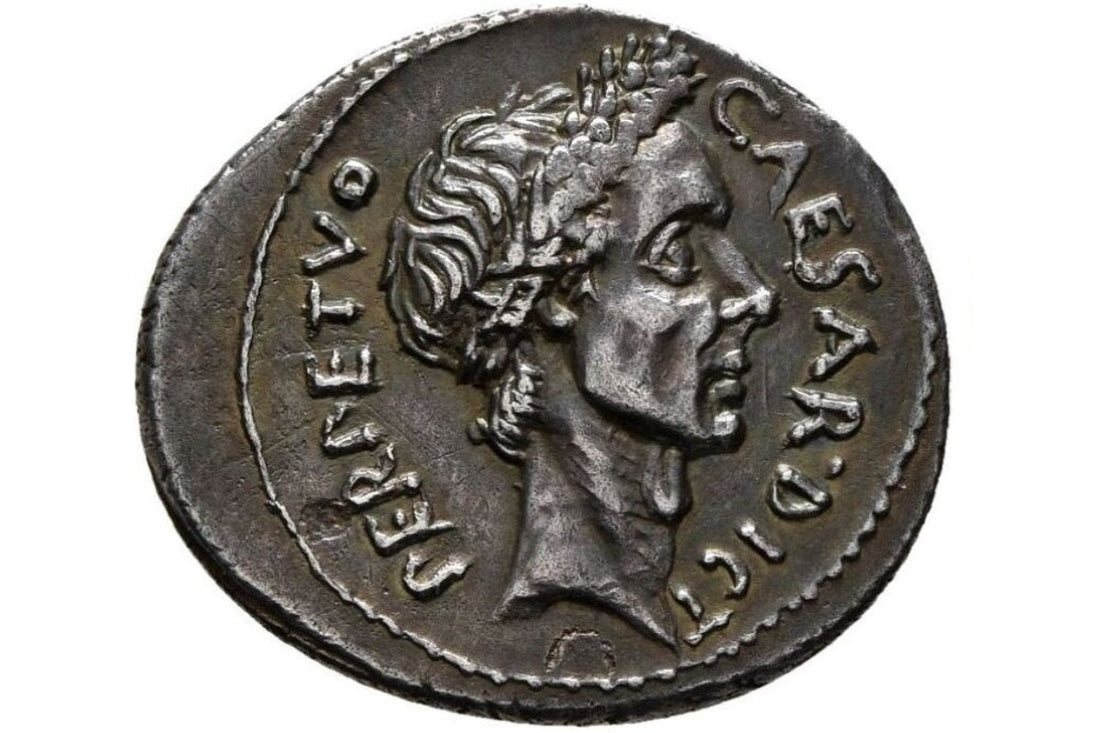
Julius Caesar Denarius (44 BC) - A Glimpse into the Divine Authority and Legacy of Rome’s Conqueror
Share
The Julius Caesar Denarius minted in 44 BC is not only a numismatic treasure but also a powerful symbol of the final year of Caesar’s life. This coin, featuring a portrait of Julius Caesar on the obverse and Venus holding a victory on the reverse, is an emblem of Caesar’s unassailable power and his divine right to rule. As one of the most significant coins in the history of the Roman Republic, this denarius offers insight into the dramatic final moments of Caesar’s rule and the transformation of Rome from a republic into an empire
A Year of Great Change: The Context of the Coin
In 44 BC, the political landscape of Rome was in turmoil. Julius Caesar had already defeated his enemies in the civil wars, been declared dictator for life, and was solidifying his authority over the Roman world. However, his increasingly absolute power was not without controversy. Many senators and political elites, fearing that Caesar intended to establish himself as a king or even a divine ruler, conspired to assassinate him. The coin minted in 44 BC thus marks a significant and symbolic moment in history. It was issued during a time when Caesar’s unparalleled power and his self-proclaimed divine status were becoming more apparent. The denarius was a means for Caesar to communicate these themes through numismatic propaganda, promoting his divine ancestry and his role as the undisputed ruler of Rome.
The Obverse: Julius Caesar – The Face of Roman Authority
On the obverse of this denarius, we see a striking portrait of Julius Caesar. His face is depicted with great attention to detail, showing the mature features of a man who had been at the forefront of Roman politics and military command for decades. His stern expression and resolute gaze are a visual representation of the absolute authority he wielded at the time. Caesar’s portrait on the coin reflects his growing cult of personality - e was no longer just a general or statesman; he had become a symbol of Rome’s future. By minting a coin with his own image, Caesar was asserting his divine right to rule, a theme that would continue to evolve after his death. The use of his portrait on Roman coinage was also a statement about his centrality to the Roman state - Caesar was Rome, and Rome was Caesar. Moreover, the image of Caesar on this coin may have been a calculated move to reinforce his god-like status. In the previous years, Caesar had already taken steps to deify himself, with titles like "Dictator Perpetuo" (dictator for life) and public celebrations of his victories. The denarius struck in 44 BC, with its prominent display of his face, served as a public testament to his self-proclaimed role as the savior and ruler of Rome, preparing the people for a future where his legacy would continue long after his death.
The Reverse: Venus Holding Victory – Divine Ancestors and Roman Destiny
On the reverse of the coin, we encounter a stunning depiction of Venus, the Roman goddess of love, beauty, and fertility, holding a victory in her right hand. Venus, however, was not merely a goddess of romance and beauty—she was also a key figure in Caesar’s divine lineage. According to Roman mythology, Caesar’s family, the Julian gens, traced its ancestry back to Aeneas, the Trojan hero and son of Venus. By associating himself with Venus, Caesar was reinforcing his divine descent and his rightful place as ruler of Rome. The image of Venus holding a victory is deeply symbolic. It ties Caesar’s reign to the theme of triumph, a central aspect of Roman identity. The goddess of love and fertility is shown not just as a figure of beauty but as one of victory—a sign that Caesar’s rule was not only divinely ordained but also destined for success. The victory in Venus’s hand could symbolize the continuation of Roman glory under Caesar’s leadership, a victory over Rome’s internal struggles, and the establishment of a new era of peace and stability. Furthermore, the victory that Venus holds in her hand suggests that Caesar’s reign was a period of triumph, and his continued rule would bring prosperity and conquest to Rome. The coin portrays Caesar as not merely a political leader but as a ruler who had the favor of the gods, and thus, his rule was a guarantee of Rome’s eternal supremacy.
Symbolism and Propaganda: A Divine Right to Rule
The Julius Caesar Denarius of 44 BC is a masterstroke of political propaganda. The coin is a powerful example of how Caesar used numismatic imagery to promote his personal brand and solidify his position as Rome’s leader.
- Divine Ancestry: The depiction of Venus on the reverse is not just a symbol of Roman mythology—it is a claim of divine ancestry. By associating himself with Venus, Caesar reinforced the idea that he was part of a divine lineage, with a destiny to lead Rome to greatness.
- Victory and Power: The victory in Venus’s hand symbolizes Caesar’s belief that his reign was fated to succeed. The coin sends a clear message that Caesar’s power was divinely blessed, and through him, Rome would continue to expand and prosper.
- Caesar’s Cult of Personality: The portrait of Caesar on the obverse emphasizes his personal image as the face of Rome. With no mention of the Senate or the people of Rome, this coin essentially presents Caesar as the embodiment of Rome itself.
- Legitimacy and Continuity: By using Venus, a figure central to Rome’s founding myths, Caesar was also signaling that his power was not an interruption of Roman tradition, but rather a continuation of Rome’s destiny. His reign, as the deified ruler, would secure the future of the Roman state, ensuring that Rome would flourish under his leadership.
The Legacy of the Julius Caesar Denarius (44 BC)
The Julius Caesar Denarius of 44 BC is a defining artifact of an extraordinary moment in Roman history. It was minted in the final year of Caesar’s life, as he prepared for his assassination by a group of senators led by Brutus and Cassius. On the day of his death, Caesar had already become a legendary figure, not only for his military prowess but also for his political acumen and his ability to manipulate symbols for his own benefit. The coin, which depicts Caesar’s face on one side and Venus with victory on the other, serves as a visual declaration of Caesar’s divine right to rule and his unwavering confidence in his leadership. The connection to Venus, a goddess who embodied both beauty and triumph, signifies the belief that Caesar’s rule was not only divinely ordained but also fated to be victorious. Following Caesar’s assassination, his adopted heir, Octavian (later Augustus), would use similar imagery to establish his own imperial rule. The idea of a divine, god-like emperor would become central to the imperial ideology of Rome, with Caesar’s divine status continuing to serve as a model for future emperors. For modern historians, numismatists, and collectors, the 44 BC Denarius remains a powerful reminder of Julius Caesar’s transformation of Rome - a transformation that was both military and mythological, where Caesar was presented as the fated ruler chosen by the gods to lead the Roman world into a new era of imperial dominance. In the grand scheme of Roman history, this coin marks a critical juncture - just before the fall of the Republic and the rise of the Roman Empire. The legacy of Julius Caesar would live on in the coins he minted, symbols that would continue to define the path of Rome for centuries to come.
